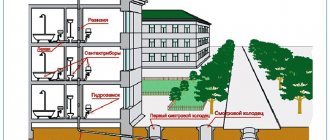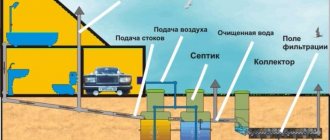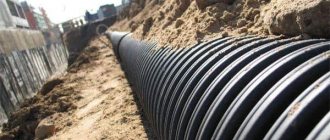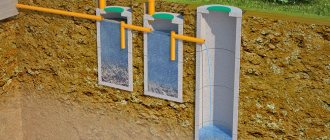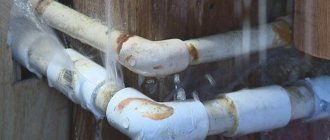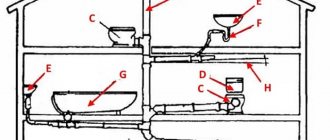A sewer plug is a valve that closes the drain hole. Such a device is necessary for the proper operation of the engineering system and to prevent leaks of the pipeline contents. Since 2011, management companies (MCs) began to use plugs as a legal enforcement tool for unscrupulous utility payers.
Methods
If you have such an obstacle in the sewer, you can use the following methods, each of which is capable of one or another
Effectively rid the toilet of a plug:
- fully repay the debt for services to public utilities (then the sewer plug will be officially removed);
- pull it out with your own hands by dismantling the toilet, or dismantling part of the sewer pipe;
- use chemicals (they are poured through an open inspection, if there is one).
With the first option, everything is clear - here you only need to deposit money. For the rest, prepare the following tools:
- a hook or metal hook with a long handle;
- hammer;
- flashlight (preferably small);
- wrenches or adjustable;
- pliers.
The use of chemicals can result in clogging of the entire riser, which will deprive your neighbors of the opportunity to use the sewer. They definitely won’t say “thank you” to you for this.
When trying to remove a drain blocker yourself, keep in mind that no one can give you a 100% guarantee of a favorable outcome.
Chemical method
The basic principle is to use alkaline components.
You can pour the drug “Mole” into the sewer yourself; it is often used to remove blockages. After reacting with water, the mixture will begin to boil and the sewer plug will gradually dissolve. It must be said that this method can only work if the plug is metal, since the rubber ball does not corrode. In addition, it will take at least a week for “Mole” to dissolve the metal.
Installation of sewer plugs for debtors
So, a debtor drain plug prevents wastewater from flowing down the system.
When installing a plug, the utility service employees will not have any problems with other apartments: the device is installed in such a way that neighboring apartments are not affected, and the drainage of wastewater is stopped only for a specific apartment.
The plugs are different. They can be made from different materials, and there can be plenty of design differences in the models. Installing sewer plugs is a fairly technologically advanced task, the implementation of which became available relatively recently.
Sometimes owners think that the drain is simply clogged and are looking for ways to break through the blockage in the toilet. But in such cases it does not help.
The stub installation algorithm is as follows:
- First, a specially trained company employee or hired specialist studies the sewerage connection diagram in a given apartment. This is done for the following reason: in individual apartments several risers are often installed, and one sewer plug for defaulters will not get rid of the problem.
- Once the diagram has been studied, the specialist begins to develop a plan for installing the plug. The key goal is to understand in what specific location the debtor's sewer plug should be installed. As a rule, such a pipe is the main riser of the apartment, located between the sewer line and the toilet.
- Then you need to find a convenient place from which it will be convenient to control your equipment. Often, neighboring apartments or a drain pipe located on the roof are used for this.
- A manipulator, a camera and a light guide are launched into the pipe. The operator controls these elements and moves the plug to the designated location. Next, it is inserted into a side branch and installed in the pipe.
After installing the plug, the movement of wastewater from the apartment stops, sometimes completely, and sometimes partially. All other risers are working, and the sewer system for all other apartments continues to function.
It must be said that a large number of companies are engaged in installing and removing plugs. In general, there is not much difference, since the cost of such services and their quality are at the same level.
Installation Rules
If you plan to do the work yourself, then it is important to understand how to install and remove the plug.
The installation procedure itself is performed in successive stages:
- Initially, the place where it is planned to install the plug is inspected in order to determine what shape and other parameters the sewer pipe has, and in certain situations even more than one riser is allowed;
- it is determined in which place of the pipe the plug will be installed, and most often the place chosen is located between the toilet and the main riser;
- the area from which the hose with the camera and the plug itself will move is determined;
- a manipulator equipped with a video camera is lowered into the pipe, and it is often replaced by a light guide;
- a plug is carried through the sewer, after which it is installed in the optimal way in the desired place in the system.
The SPRUT sewer plug is installed for debts
Equipment for installing sewer plugs
Installing a plug in a sewer riser from the roof of a house
Metal plug - view from the inside
After carrying out the above steps, a certain section of the sewer system is closed, and it can be long or short, depending on the purpose for which this work is being done.
As a rule, this process is required to disconnect defaulters or when laying a new sewer network. It is carried out by professionals, but if you need to carry out complex major repairs in a house or apartment, which also affects plumbing, then it is often necessary to install a plug yourself. If you choose the element wisely and install it in accordance with the basic rules and safety requirements, then this work will not cause any problems or difficulties.
How to remove
Turning off the sewer system is rarely required, but situations may arise in which it is necessary to remove the plug to ensure the sewer system is connected to the house or apartment
It is important to understand this procedure to ensure perfect results.
How to remove a plug from a sewer? This process depends on which element you are dealing with:
- if a rubber plug is installed, it is simply pierced, for which any cutting tool is used. The element has thin and soft walls, so there are no problems with its deformation. To do this, a metal and sharp tool is lowered into the pipe using a plumbing cable. After cutting the rubber plug, it deflates and simply falls out of the system;
- if there is a product made of plastic or metal, then it is quite easy to move it in any direction, and this process is carried out either manually or using standard pliers. It is advisable to pull it out so that it does not remain in the system. To do this, just tighten the stop of the plug. If it is not possible to pull it out of the pipe, then it must be fixed with a spacer so that it is not washed away by wastewater;
- It is often impossible to move hard metal or plastic plugs. In this case, a hole is formed in the riser, and in such a way that it is at a convenient angle to the plug. A metal pin is inserted into the resulting hole until it hits the product. You need to hit it with a hammer to move the plug;
- in a plastic element it is enough to simply make a hole with a sharp knife, and a core drill is often used for these purposes. It is not recommended to use this method for metal products because they are springy. Therefore, it is most optimal for them to use an angle grinder. The cut elements are simply pulled out of the system;
- if there is a lattice structure, then you just need to saw or cut through the existing rods.
If the work must be performed by the owner of an apartment located on the top floor of an apartment building, then access to the pipes is easy to obtain through the roof or attic of the building.
You can even remove the plug from the sewer yourself using chemical methods. For this purpose, special products containing oxalic or hydrochloric acid are used. However, in reality, this method is characterized by low efficiency and effectiveness.
Also, when using aggressive chemicals, there is a high probability of causing irreparable damage to the pipes themselves. The products begin to work after several days of use, so the process is delayed for a long time.
If you perform the process carefully and efficiently, you can use the plug again for another section of the sewer system.
Thus, sewer plugs are effective and efficient tools that allow you to block the sewer riser if necessary. They are represented by several types, differing in installation principles, service life and production material.
Their installation is a rather complex and specific job that requires specialized equipment.
If you need to remove an element, then it is important to figure out which method for these purposes will be the most optimal and effective, and its choice depends on the type and installation features of each structure
If you take the work responsibly and seriously, then there is a high probability of receiving a high-quality element that can be reused after dismantling.
Methods for removing the plug
There are several methods for removing clogs from a sewer system. The choice depends on the type and type of plug, the location of its installation and the option of fastening to the main line. In all cases, care must be taken not to damage the pipes or cause injury during operation. Let's look at the features of each method.
Chemical
Since locking devices and devices are initially designed for contact with an aggressive environment, you should not count on instant results. It will take time to break the structure of metal or plastic.
You can fix the problem using the following methods:
- gels based on acid that corrodes metal;
- component preparations that, when mixed, emit heat that softens the plastic.
You can get rid of iron parts using Coca-Cola. This drink causes it to corrode.
Mechanical
The easiest way is to disconnect the flange plug. It is enough to pry it by the cover with a screwdriver and pull it towards you. When unscrewing plastic caps, difficulties may arise due to dirt accumulated in the threads. It is necessary to apply warm soapy water into the opening and wait a few minutes. After this, tap the lid with a mallet - it will move and unscrew easily.
If the cork was placed on glue, then you first need to saw off the cap, and then cut and break the ring.
The pneumatic plug is removed with a plumbing cable. A hole is punched in it into which the hook is inserted. With little effort, the device is removed from the pipe.
Types of sewerage closures
Utility service provider companies independently decide the extent to which they can restrict access of defaulters to the sewer system. When apartment drainage systems exit to 2 or more risers, a plug can be installed on one pipeline (with fecal waste), leaving the water supply free.
Plugs for sewer pipes are also multi-variant. There are solid and lattice.
- Solid. The most radical way to solve the problem. Utilities completely shut down the sewer system. With zero drainage, it is difficult for apartment residents to ensure normal life activities.
- Lattice. With their help, the debtors' sewerage system is not completely turned off. Liquid fractions pass freely into risers. Solid organic matter will remain in the pipe. As the water line becomes clogged, the flow of water will also become worse. This method allows the tenant to defer payment of the debt.
How to place
Permanent plugs are installed during the installation of the system during the construction of a house. To do this, a tee connection or outlet is mounted in the required location, and a plug is inserted into the socket.
The plug is also placed in the inspection window in the pipe riser so that it can be pulled out at the right time. The main purpose is to provide easy access to the pipe trunk during cleaning or work with the sewer.
Another task solved by the shutter is the temporary cutting off of some sections of the pipeline that will be worked on in the future, as well as preventing unwanted odors.
Temporary plugs are installed both in the main pipeline to cut off a section of pipe and subsequent work with it, and in an apartment building to stop drainage in a specific apartment.
Alternative option
If the toilet is securely fixed to the floor or removing the plug from the sewer is impossible, but there is an inspection hatch, it makes sense to work through it. In this case, you need to be careful, because waste or hot water may pour from above; do not neglect protection. It's simple:
First, the inspection window or hatch opens. You need to have a harpoon or a long stick with a hook, which will need to be used to pick up the plug. There is a possibility that the tool will slip out of your hands and fall down, making it impossible to get it out.
Therefore, it is worth tying a rope to the end and leaving it outside so that you can intercept it if something happens. Carefully pry the plug and remove it. You need to act very carefully so that it does not fall and block the riser.
After completion of the work, the hatch must be closed and the plumbing installed in place.
Methods for removing the plug
Many consumers are interested in how to remove the plug from the sewer themselves and how legal it is.
To understand how to remove a drainage blocker, you need to know the general design of connecting the sewer system to a common riser. Technically this is a complex procedure. Special equipment is needed to remove a toilet filled with feces .
If the riser is made of PVC or metal-plastic, the procedure for removing the plug is less problematic. It can be removed chemically or mechanically. However, in the absence of experience and knowledge, the entire riser can be clogged or damaged.
As for the legality of hacking a system on your own, in practice not a single enterprise has been able to prove that the stub was removed . If they notice the device is missing, they simply install it again.
Among the types of equipment capable of installing plugs mechanically are “Kit”, “Octopus”, and a shut-off valve.
Blocking by the Sprut system
The equipment includes a manipulator, a video camera and a probe . The plug leaves a gap of 3 mm: this is enough to drain contaminated water. However, the drainage system in the apartment will not function fully.
Blocking with “Kit” equipment
The system works on a similar principle with Sprut equipment. The components include a reel with a cable wire, a probe with a video camera, a control panel and a plug with a lock. The probe is brought through a common riser to a specific outlet, and a plug is installed in this place.
Stop valve
The shut-off valve locking system prevents wastewater from moving back up. This device is installed in apartments on the first two floors. In residential areas located above, shut-off valves are not relevant.
Operating principle of the drainage blocking system
Which method of exposure to choose, turning off the lights or limiting water disposal, is decided based on specific conditions. Less hassle of cutting the light. When this cannot be done for some reason, the owner will face no less severe measures. This is the installation of a plug in a sewer riser. Why is this method chosen, and not turning off, for example, the same hot water that is permitted by law? The reason is in the design of utility networks. Of course, you can shut off the hot water riser, but this will leave all your neighbors without water. To turn off the water only to the debtor’s apartment, you need to enter his territory. It is easy to imagine what the debtor will answer when a locksmith calls him, offering to let him into the apartment, where he will turn off the hot water. At best, the plumber will have to listen to the owner’s non-literary monologue and instructions on which route to take. Therefore, a method was found to put pressure on non-payers by specifically blocking the sewer system using a plug. In this case, not a single apartment connected to the same riser as the debtor’s apartment will be affected. It is easy to understand how a stub works using the following example. Imagine many small streams running from the mountains and flowing into one river. If you block one stream with a dam, the others won’t care. They will also flow into the river; the dam will not stop them. A plastic plug installed in the sewer system works on the same principle.
Sewer plug design for non-payers
What does a formidable weapon in the fight against a debtor, a sewer plug, look like? Imagine an ordinary pipe with a diameter of 100 mm, about 20-30 cm long, cut in half lengthwise. One half of such a segment is that same stub. Its convex part is attached to the sewer outlet of the debtor's apartment, and the concave plug looks at the common riser, without interfering with the drains from other apartments being freely removed.
What does the sewer plug installation system consist of?
Equipment for blocking sewers for housing and communal services debtors is produced by different factories and manufacturers. This is not a cheap gadget, but management companies spend the money because the result justifies this expensive purchase. The kit for installing the plug includes:
shockproof control panel with monitor, it has a built-in battery, can work from the mains or autonomously;
a waterproof probe with two video cameras built into it, they work in any, even aggressive, environment;
DVR for recording video of installation or dismantling of the plug;
flexible hose for lowering the plug into the sewer system;
control panel and the plug itself.
The entire complex of work must be carried out by two people. It will take no more than 30 minutes to install the plug in one apartment.
Installing a drain plug
Before installing the plug, utility workers check the layout of the risers in the apartment, the number of risers, and the working condition of the sewerage system. If there is a blockage, you will not be able to install the plug. If the risers are in good condition, the debtor is notified that a sanction has been applied to him in the form of blocking the drains, you can proceed directly to the process of introducing a plug. Having climbed to the roof of the house, they determine the location of the drain pipe of the riser of the “bad” apartment. Through it, a plug attached to the probe is lowered to the debtor’s apartment. Its progress is monitored on the monitor. As soon as the plug reaches the sewer outlet from the debtor's apartment, the operator on the roof, using the control panel, disconnects it from the probe and the plug is inserted exactly along the cross-section of the outlet. The sewage drain from the debtor's apartment is blocked. The plug has a special retainer that helps it stay in the pipe opening and block the flow. You can also remove the plug using equipment. It will be difficult for the debtor to remove the interfering device on his own, although there are ways. True, they are labor-intensive. The easiest way to get rid of the stub is to pay off the debt. Within 1-2 days after repayment of the debt, utilities will restore sewerage.
General information
Types of locking systems
There are different types of blocking. The plugs of different systems have distinctive characteristics.
Common devices include the Whale and the Octopus.
The SPRUT plug includes a video camera, a long probe, a blocking plug, and a manipulator.
Positive characteristics of the plug:
- -has a video camera.
- - blocks the sewer riser completely or in parts.
The device is pushed into the sewer pipe through the ventilation, where it blocks the drainage hole completely or partially.
The pipe will not change its geometry, and neighbors in the house will not experience restrictions on the use of the sewerage system.
The plugs are made of steel, which resists aggressive environments and is also not subject to mechanical stress.
The KIT lock has a probe with a control panel and a camera.
Positive characteristics:
-has LED lamps, with the help of which they find the desired apartment.
-has a control panel, you can control the operation of the system from a distance.
The blocking probe passes through the central riser to a specific outlet location where the plug is installed.
Less popular plug systems include:
1.Glot, equipped with a cable with a manipulator at the end and a small video camera.
2.Terminator Pro.
3. The Sov has a plug in the form of a polymer sleeve, which is pressed into the section of the pipeline where there is a debt and closed with a lock.
To remove the blocking, you must pay the debt for the apartment in full.
Stub - a form of dealing with debtors
There are two types of locking systems:
-absolute view covers the waste drain in full.
-the lattice type partially blocks the passage of sewage, allowing passage only for liquid forms of waste.
If the debt is two months old, then housing services have the right to install a plug.
The management organization does not have the right to enter an apartment with debts; it is forced to block the sewer system so as not to cause inconvenience to the neighbors.
Features of installing the plug:
1.specialists study the pipeline diagram and select a location for the plug.
2. determined using one or type of plug.
3.set the lock using a manipulator with a video surveillance camera.
The operator monitors the installation process from start to finish.
Before installation, the defaulter receives a notification that restrictive measures are being applied to him regarding the provision of sewerage services.
If the sewer is closed without warning, the debtor can sue the management company for illegality of action.
Based on judicial practice, it can be argued that this type of case ends in favor of the plaintiff.
The procedure for installing and removing a sewer plug
Almost all multi-storey buildings have a central riser that runs through all floors and ends in a vent pipe on the roof, which is necessary for ventilation and air access to the duct. Therefore, theoretically and practically, installing a plug through a pipeline from the roof to any apartment does not present any particular difficulties; operations are carried out in the following sequence:
- Using a special camera and lighting, the condition of the sewer riser (the surface of the inner shells of the pipes) in the overlap area is studied, and based on this, the type of plug is determined. At the same time, the material of manufacture of the riser is also taken into account - different types of plugs are installed on smooth polyvinyl chloride (PVC) plastic and cast iron pipes rough on the inside.
- Next, they begin to immerse the plug, models with sharp teeth are lowered into a PVC plastic pipe for fixation on smooth walls, and self-expanding structures are placed in cast iron risers.
- After the user pays the rent in full, representatives of the installation company return to the roof and lower the manipulator into the sewer shaft. An operator-controlled device compresses the sliding structure or releases air from the ball, after which it removes the plug to the surface.
Rice. 8 Placement of cylindrical plugs in the sewer tee
How to remove a plug in a sewer and can you do it yourself?
Considering that the consumer-debtor has the right to legally not allow employees of the management organization into his apartment, it is problematic to prove the fact that the plug was removed. The tenant can always claim that he knows nothing about its fate and suggest that it was poorly installed and fell into the riser shaft itself.
There are different methods of how to remove a plug from a sewer yourself, depending on its specific design, the material of manufacture of the riser pipeline, the main ones are:
Universal . Since the damper is located at the outlet of the riser pipe, to which the toilet is connected through a corrugation, the easiest way is to remove the plug from the sewer by dismantling the plumbing fixture. To do this, unscrew the two screws securing the toilet to the floor, close the valve and disconnect the flexible cold water supply from it, after which the device is removed from the toilet room. Next, remove the corrugation and observe the plug itself in the short outlet pipe of the riser.
If a pneumatic model in the form of an inflatable ball is installed, it is pierced with a sharp object and removed by hand. If a cylindrical damper is placed in a riser channel, it is destroyed physically - the metal (polymer) plates are damaged with a steel crowbar or a nail puller, a hole is drilled around the perimeter of the pipe with a long drill using a drill, after which the passage is cleared or the plug falls into the sewer. If there is a mesh, you can cut it with metal scissors or expand the cells with a crowbar for better drainage passage.
Chemicals
At the moment, there are a large number of drain cleaning products containing oxalic or hydrochloric acid. They will be able to corrode the plug, but provided that it is iron, and the owner must have time and patience, since the result will be noticeable no less than seven days later.
Which method to choose depends on events and the availability of plumbing supplies. Mechanical intervention is a troublesome process, but the most effective. The chemical method of solving the problem is less effective, but is justified by its simplicity.
Installing plugs is an extreme measure that water utilities or communications companies should take. And if they become aware that the plug has been removed, they are more likely to reinstall it.
Comfortable use of the benefits of civilization is unrealistic without paying for them. Based on this, if you diligently pay for housing and communal services, then, under no circumstances, will you need to deal with the removal of plugs, doing hard, unclean, and from time to time, hopeless work.
Can utility workers turn off the sewer system?
Many citizens are interested in whether sewerage can be blocked for debts. The thing is that in the current version the direct ban on turning off the sewer system has been abolished. In this regard, management companies (MCs) that collect payments are now threatening defaulters with suspension of the resource supply.
It states that the only way to influence malicious debtors and non-payers of housing and communal services is to limit or suspend water drainage and water supply.
At the same time, in search of an answer to the question of whether housing and communal services can turn off sewerage, it is worth considering that the above-mentioned resolution contains an important condition, according to which the suspension of any type of utility services should not:
- damage the common property of residents of an apartment building;
- violate the rights of other owners, including the suitability of residential premises.
Therefore, if a consumer doubts whether the sewerage system in the house was legally turned off, you can go to court to stop interfering with the sanitary and technical condition of the apartment building equipment.
Is removing the plug a crime or not? Is there a punishment?
If you are interested in whether removing a locking device is punishable or not, you need to refer to the regulations, the same government decree No. 354. The document does not say anything about this. But liability may arise when general damage is caused to the house or its individual occupants.
The fact is that inexperienced “chemists” begin to pour caustic liquid into the pipes, trying to dissolve the locking devices in it. As a result, the drainage material dissolves. The consequences of this will be very predictable: expensive and time-consuming repairs will be required.
Some enterprising enthusiasts create pressure in the sewer or try to remove the plug using improvised tools. The installation of unwanted barriers is carried out by real professionals, so you should not expect that the plug will pop out by itself.
But the fact is that dismantling is also carried out by experienced specialists, and not necessarily representatives of utility services. These may be private commercial structures. They charge money for their services, sometimes a lot.
But what happens if you remove the plug? Neither the Code of Administrative Offenses nor the Criminal Code stipulates responsibility for this, and no officials will be able to obstruct arbitrary actions.
The sewer pipe is the property of the resident, and he has the right to do whatever he wants with it, but not to the detriment of other residents. Therefore, it is cheaper and safer to pay off the debt altogether, or use the services of private masters.
Within 2 days after payment of the debt, the plug is dismantled by representatives of utility services. If no action is taken, the apartment owner can file a complaint with the prosecutor's office.
Why install a plug on a sewer pipe?
Pipe plugs perform different functions.
The purpose of the plugs depends on their location. Such elements are installed when assembling the system. They are necessary in the following cases:
- Installation of the system with a reserve. In this case, we are talking about main pipes that remove sewage from the apartment. The architecture of the system, even within an apartment, can change. New devices and elements are added to it, and the configuration of the pipes changes. A simple example: installing a sewer system in an apartment. At the moment there is no washing machine in the bathroom, but there may be one later. A branch is made in the sewer pipe under the washing machine and a plug is attached to it. Until the device is attached, this thread will be closed. When it becomes necessary to connect a washing machine to the sewer, the plug can be removed.
- Construction of large highways with branches to new branches. Construction work is constantly going on in large cities. There are more houses, but it is difficult to constantly rebuild the sewer system for new buildings. To do this, even when installing the sewer system, spare dead-end branches are created, onto which plugs are attached. Their difference from household ones, which are used to change the sewer system within one apartment, is exclusively in their large size. If necessary, it is removed and the outlet is connected to the pipe system.
- Revision. The sewer system must function continuously. The problem is that sewage carries various impurities that can clog pipes. To remove blockages, access to various sections of the pipe is necessary. For access, blind bends are used, to which removable plugs are attached. If a blockage occurs, the plug can be removed, special tools inserted into the outlet, cleaned out the pipe, and then put back on.
- Overlapping a specific branch. In those places where main sewerage pipelines branch into smaller ones, plugs are needed. They will be needed if you need to shut off drains from individual parts of the system. For example, in the place where the pipeline from the apartment connects to a common riser, an outlet with a plug is required. In the event of an accident or repair work, plugs are installed and part of the system is turned off from operation.
Features and purpose
As you know, sewerage deals with the removal of wastewater, human waste and industrial waste.
There is no way to do without it, because all the waste needs to go somewhere. Nowadays, on average, a person processes about 200 liters of liquid per day. This is the liquid spent on personal hygiene needs, household needs, cooking, etc. It needs to be drained somewhere, which is what the sewer system does.
Sewerage is laid mainly underground. Unlike water supply pipes, there is no need to gain access to it. Unless the pipe cavity becomes very clogged. But even in this case, they mostly make do with improvised means.
However, there is a second point. A sewer laid once (and not necessarily underground) is not so easy to expand. That is why builders try to foresee possible consequences in advance, installing wiring in advance in places where new branches could potentially form.
In the future, the pipe will no longer have to be opened, removed and replaced with another sample. It is enough to connect a new branch to the finished output.
So the plugs are precisely used to block the sewer outlets. They are easy to install and just as easy to remove.
This method has been used for a long time. To install a plug on a pipe, it is not necessary that it be underground. They act in a similar way during the construction of sewer risers.
Permanent PVC plug
An additional outlet of the riser will not hurt anyone, since the plug on it completely blocks the empty outlet. But there are a lot of benefits from it. Just imagine how much time and effort it takes to cut into a finished riser. Introduced? That's it.
Another area where plugs are often necessary is situational blocking of sewer pipes.
There could be many reasons for this. Starting from carrying out regular repair work, and ending with cutting off debtors from the sewer system. In any case, it is the plug that performs the basic functions of stopping the system. Without it, a person would have to spend tens of times more effort and energy on this simple process.
How difficult is it to remove the plug yourself?
As you might guess, when developing the impact method under consideration, utility services did everything in their power to prevent
remove the obstacle without their knowledge or consent.
Nevertheless, it is possible to fix it yourself, even if you are not a plumber.
You need to know that there are a number of factors that make work difficult. So:
- the plug is installed for non-payment using a special manipulator - this equipment is available only from the specialized service;
- to remove it in your apartment, you will need to remove the toilet;
- work (both in the old house and in the new building) is carried out blindly;
- During the extraction process, there is a high risk that sewage will spill directly onto your floor.
Installing the valve on the riser
Residents of apartments located on the lower floors have the worst situation when the sewer is clogged. All the sewage entering the riser from the apartments located above begins to pour out of their toilet.
To prevent flooding of your apartment with fecal waste, it makes sense to install a check valve on the riser. This device ensures fluid flow in only one direction; reverse flow is excluded.
Installing such a valve on the first floor will lead to the fact that if the sewer is clogged, fecal waste will begin to flow into the apartment located on the second floor. And if a valve is installed there, the problem will “move” even higher. So installing valves on each floor will help avoid such troubles as flooding of the apartment with someone else's fecal waste.
Advice! The cost of a check valve is approximately 200 rubles, that is, the price of safety is quite low.
Useful tips
If a management organization practices installing sewer plugs in the apartments of debtor users, one of the useful tips is to prevent such a situation. In addition to the significant inconvenience of living without a sewer system, the amount of debt for utilities will increase even more due to the cost of installing a shutter device.
If you choose the lesser of two evils, it is better to allow the contractor’s workers into the apartment and allow them to put a plug on the hot water; without it you can live much more comfortably than without sewerage.
The only problem that may arise for residents of the lower floors is the possibility of installing a plug from below using rods; in this case, you will have to drill the pipe and install a pin (screw in a bolt) at the level of the inlet sewer pipe into the riser and the plug will not be able to be installed on either side.
Legality of eliminating the problem
Let's figure out what to do when the debtor has a plug installed on the sewer. The best solution, which does not require additional expenses and does not have unpleasant consequences, is to pay the debt in full. The problem will be solved within two days (the period within which the management company is obliged to unblock the drain hole).
You can also try to come to an agreement with the management organization and sign an agreement on phased settlement or challenge the actions of the contractor in court. Often the courts side with the consumer, especially if the deadlines, notification procedures and gradual disconnection from services are violated.
As for whether the debtor has the right to get rid of the stub on his own, there is no clear answer.
In 2021, the Supreme Court of the Russian Federation recognized the illegality of applying such measures to non-payers, since they violate sanitary standards and make it impossible to use the premises. But the conclusions of the highest judicial body in the case are advisory in nature for other courts and do not prohibit the Criminal Code from introducing restrictions.
We are inclined to believe that in each specific case, the illegality of installing a device must be recognized by the court, and dismantling of the product can only be done after such a decision.
Until then, any actions can be regarded as arbitrariness. If, after the defaulter decides to remove the plug from the sewer himself, harm is caused to other residents or the management company, then this fact will entail liability for the owner.
How to use the toilet if you put a plug on the sewer
- A specialist or a trained employee of the management organization studies the connection diagram of the sewerage system in a certain apartment. This is done in order to find out how many drains are in the room and how many plugs are required. After all, if there are several drains in the apartment, then one device will not be enough; residents will begin to use the free drain.
- After studying the diagram, the type of plug and the place where to fix it are selected. Most often, the device is placed on the main riser, which runs from the general sewer system to the toilet.
- Next, plugs are installed on the sewerage system for housing and communal services debtors. A manipulator, LEDs or a video camera are remotely sent into the pipeline and controlled by a service employee.
Therefore, from the point of view of the law, it is possible to remove the plug using methods to clear the sewer from blockages. Of course, you will need skills in working with plumbing. One of the methods involves removing the toilet, since the plug is installed at the entrance to the apartment sewer. The first connection after the socket is the outlet to the riser; the plug should already be visible there. It must be pulled out, otherwise it will block the entire riser. Conclusion There are actually many methods, but their use can be unsafe and lead to even worse consequences. Therefore, it is best not to bring the situation to such radical methods and pay all utility bills on time. After installing the plug, the drainage from the room is partially or completely blocked.
How services are resumed After Resolution 354 came into effect and utility companies had the right to influence debtors by turning off some services, the amount of utility debts became much lower. Of course, this was predictable, because living without a toilet in an apartment is almost impossible! According to paragraph 120 of Resolution 354, the supply of services must be restored within a maximum of two days after: Removing the fixture Some defaulting owners, not wanting to be left without amenities, independently remove the plug in the sewer. Are debtors acting legally? In principle, their actions cannot be called illegal. Of course, the best way to get rid of inconvenience is to pay off the debt.
In this case, the specialists of the service organization will remove the plug themselves.
- Housing Code of the Russian Federation, Article 155, according to which residents are obliged to pay utility bills on time in full;
- Government Decree No. 354 of May 6, 2011, Article 119 provides for the right to restrict the provision of services or completely suspend all services. (Exceptions are heating and cold water.);
- Government Decree No. 491 of August 13, 2006, paragraph 29 includes costs incurred for debt collection at the expense of the payer.
At the same time, it is prohibited to disconnect the entire house from services if at least one person in it pays utility bills on time. Representatives of the RSO most often fail to get into the debtor’s apartment to turn off the gas or water supply, so there is only one thing left to do - shut off the sewer. Legality of the procedure The question of whether it is legal for debtors to install sewer plugs is of concern to many.
The law states that completely cutting off the supply of resources, such as heat or water, is prohibited.
Removing the plug: the price of the issue
Before you find out how much it costs to remove a drain plug, try to solve the problem in a more legal way. Find an opportunity to pay your utility bills or ask for an installment plan from the management company.
There is demand - there is also supply. If paying for the removal of the plug seems more economical to you, you can contact the appropriate services. Service companies price their services from 2.5 to 5 thousand rubles. Private craftsmen charge less - 1.5-2 thousand rubles .
If it is necessary to install an anti-plug, you will need to pay an additional about 3 thousand rubles. But how to find out whether it is worth applying for the provision of this type of service, everyone decides for himself.
Types of sewer plugs
The sewer system is designed to drain wastewater from residential, industrial or other structures.
It is created underground and is represented by a system of pipes, and wiring is certainly created in places where it will presumably be necessary to create an additional branch. Unused outputs are blocked using plugs.
They are also used in case of situational blockage of a sewer pipe, and the reason is repair or disconnection from the debtor’s system. Several types of plugs are available, each with its own parameters and features.
Permanent
Installation of permanent sewer plugs is carried out for a long period. Presumably, the structure is installed for several months or even years.
It is usually used when a full-fledged sewer system is being formed, so tees and bends are made in certain areas. In the future, they will be used to connect new facilities to the sewer system.
The permanent element consists of a housing made of metal or high-quality polymer. Therefore, it is represented by a regular lid with a convex shape.
The most commonly produced permanent plugs are made from:
- PVC - made of lightweight gray plastic. They are distinguished by high strength and affordable cost. Easily withstands numerous negative external influences. However, they are considered not very reliable, therefore they are used as locking items in the process of creating or repairing a household system located directly on the premises;
- plastic in combination with other substances - this material produces elements that are highly reliable and durable, therefore ideal for laying outside buildings. Used in the process of forming a system underground. They are usually painted orange. They can easily withstand even strong pressure.
Permanent plugs inside contain seals that seal the item and also reduce pressure on it. Installation of these elements is considered simple, and it is usually implemented at an early stage of construction of any structure.
The assembly process does not take long, since the plug is simply installed on the pipe, after which it is clamped until it occupies the desired position in the system. Next, the joints are sealed, if necessary. Therefore, making a sealed sewer outlet is not difficult.
Temporary
They provide sewerage restrictions in an already functioning element. They are represented by specialized devices that have the same shape as permanent objects.
Inflatable
They are used quite often, and the principle of their installation is simple. For this purpose, a special device is used, equipped with a hose of significant length. The inflatable plug is represented by a rubber ball equipped with teeth, and it is this that is connected to the hose.
The hose is equipped with a special chamber and several handles to ensure ease of use. The element is lowered into the sewer riser, and most often the upper access point located on the roof is used for this.
Mechanical
The mechanical elements are represented by rather complex structures equipped with shields. These elements are used in a certain sequence of actions:
- the necessary elements for work are prepared, and these include a camera and a machine for installing the element, as well as a hose;
- the assembled plug is located inside the riser;
- she moves to the right place;
- then an electrical signal is supplied to it, leading to the expansion of the plug;
- The element shields are fixed to the walls, therefore automatic blocking of the outlet is ensured.
Thus, installing a mechanical plug is considered a simple and quick process.
A specific type of plug is selected for a specific pipe, so a metal structure is purchased for cast iron pipes, and PVC products are purchased for plastic pipes.
Why do you need a plug for sewer pipes and how to install it?
A part such as a plug for sewer pipes is used to block certain sections of the drainage network.
They are installed by the owners themselves to temporarily or permanently disable a separate branch of the network. In addition, plugs are actively used by utility companies, since the installation of this part is one of the most effective measures to combat debtors. A plug is installed on a sewer pipe for different purposes. This could be a temporary shutdown of a backup branch or a permanent blocking of a part of the system that has become unnecessary.
Installing an inspection with a plug is necessary to be able to clean the sewer. Such a fitting with a diameter of 110 is placed on the central riser. Recently, management companies have begun to actively use stubs in an attempt to get debtors to pay utility bills.
Any plug, regardless of the scope of its application, performs the same function - blocks movement. When using this part in a sewer system, it blocks the flow of liquid.
Plugs for installation in the sewer system are made of the same materials as the pipes, that is, plastic or cast iron. In addition, there is a special type of plugs - pneumatic.
Advice! It is very important that the sewer pipe plugs are made of the same material as the pipe itself. You cannot place a cast iron part on a plastic pipe and vice versa. But there are also universal options that utility companies use.
According to the installation method, there are two types:
- Permanent. They are installed for a long period.
- Temporary. They are installed for a short period, for example, during repairs.
Based on the type of fastening, the following types are distinguished:
- with flange connection;
- covers with a sealing ring made of elastic material;
- parts with threaded connections (usually used on metal pipes);
- Welded parts are parts that are permanently fixed.
The following types of plugs can be installed by utility services:
- Mesh. This type allows liquid waste to pass through, but retains solid waste.
- Pneumatic. A pneumatic plug is installed to shut off a separate riser in the general sewer system.
Types of stubs
Despite the fact that the range of these particular fittings is small, there are still some significant differences. Let's look at them in a comparative table.
| Product type | Highlights |
| These parts are intended for installation indoors and have virtually uniform wall thickness. Only the diameter of the product can be different. |
| Such plugs are made for outdoor use and can have different weights and different thicknesses of plastic. Fittings, which are classified as light and medium type, are distinguished by the fact that their price is quite affordable, and in addition, their scope of application is operation at a depth of up to three meters. Heavy type fittings are important to use for deeper installation, as well as in places where the site is subject to enormous loads (this could be a parking lot, for example, or a road). |
As you can see, everything is quite clear here, due to the fact that there are really few selection options.
Pay attention to one fundamental point! It is very necessary that the manufacturers of pipes and fittings for internal or external sewerage be the same. In another case, there is a high risk of difficulties arising (difficulties here arise due to the fact that, due to different equipment in factories, there are errors in the diameter of the products) when connecting them with your own hands
Let's now look at how to install this type of connection.
Purpose of the device
The plug is a kind of valve that closes the sewer hole intended to connect the common riser with the system of a separate apartment. This method is used by utility service employees when non-payers do not allow them into the apartment.
The partition is installed on a branch from the common riser.
The device is inserted through a drain pipe that goes into the attic, and a valve is installed. It prevents waste from passing through the drain. Accumulating near the plug, they clog the toilet and pipes that extend from the bathtub and sink.
The rate of clogging is determined by the type of valve. If it is made in the form of a lattice, then water will pass through, and only solid particles will accumulate. When installing a solid plug, the side hole is completely blocked.
This is interesting: Step-by-step instructions for repairing a ball valve: it’s better to see once
What it is?
A sewer plug is a device designed to block individual branches of a drainage system or the entire riser.
The products block the lumen of the highway completely or partially, retaining only solid objects. They contain wedge-shaped or petal-type shut-off valves. Installation is carried out during the initial installation of sewerage or during operation, when required by production or other needs. Locking devices are made from plastic, metal and rubber.
Types of plugs that can be installed in the sewer
Countering defaulters is aimed at quickly collecting the debt, so the sewerage restriction must be reliable. Today, controllers use two types of stubs, namely:
- continuous - ensures complete cessation of sewage movement;
- lattice - solid elements will remain level, gradually forming a blockage, and the liquid will drain.
In any case, the owner of the apartment and its residents will experience serious inconvenience. The restriction will remain in effect until the debtor makes payment.
